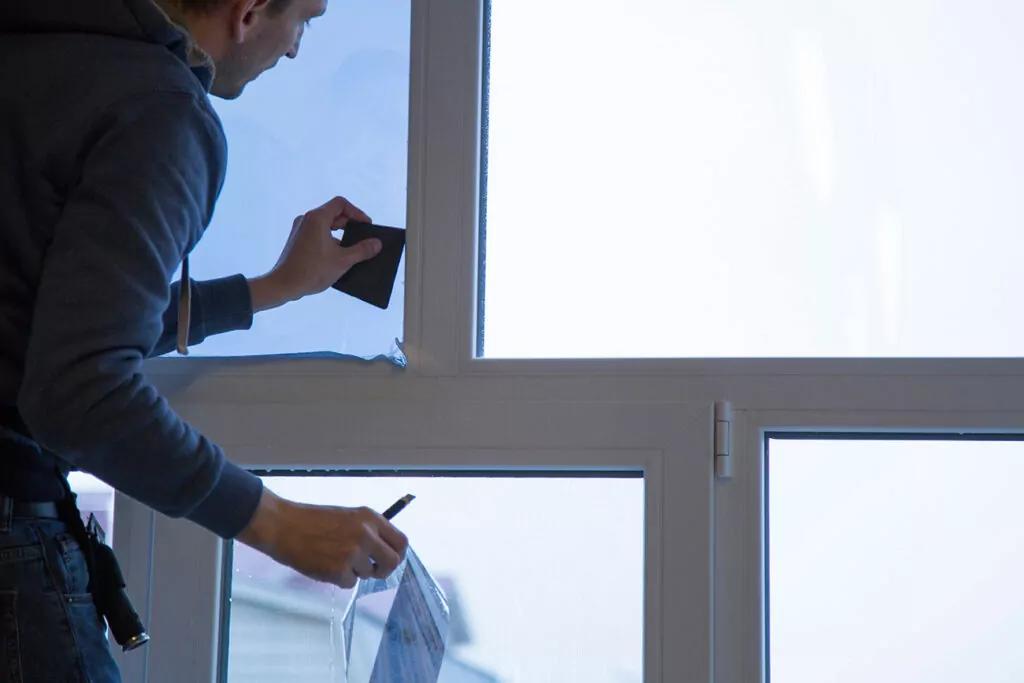As seasons change, keeping your home either warm enough or cool enough becomes a priority. During winter months, nothing is worse than waking up to a cold house, cold floors, and goosebumps. During summer months, it’s equally challenging when you’re paying to air condition your house and the greenhouse effect from old windows is heating up that expensive cool air. With all these considerations comes the question of how to insulate windows. Do you use window insulation film? Weather stripping? Basic caulking? And what on earth is a draft snake?
Once you find yourself wondering how to insulate windows, you’ll have to face all of these questions. Drafty windows are a major culprit for heat loss in the winter and seeping air conditioned air in the summer. Both of these challenges lead to energy inefficiency, and by addressing them before they become too serious, you can trap air inside, minimize drafts, and potentially see significant savings on your energy costs. In this post, you’ll discover various window insulation methods, ranging from quick DIY projects to more permanent solutions like new windows built with multiple window panes.
How To Insulate Windows
Your heating bill matters, as does the use of energy it requires. Since new windows aren’t always an option for everyone, there isn’t always a simple answer when you’re trying to figure out the best way to insulate windows. Below is a breakdown of various window insulation techniques and approximate costs, materials needed, and methods to implement this type of home improvement.
Bubble Wrap

This is a surprisingly effective and budget-friendly method for insulating your windows. First, clean your window frame so there’s no dust. Then measure and cut bubble wrap sheets to fit your windows. Use double-sided tape to stick the bubble wrap (with the bubble wrap facing inward) across the entire cleaned window frame, covering the window.
- Cost: Under $10
- Materials: Bubble wrap, double-sided tape, and scissors
Weather Stripping

This involves applying self-adhesive strips around the edges of your window sashes to seal gaps where drafts can enter. Choose the appropriate weather stripping size based on your window gaps. Weather stripping is easy to find at hardware stores and comes in various sizes.
- Cost: $5-20 per window, depending on the size
- Materials: Weather stripping, tape (optional), utility knife (optional)
Window Insulation Film

Window insulation film is a type of plastic sheet that can create an additional insulating layer on your windows, which is great for winter months. Window insulation kits typically come with pre-cut window film and double-sided tape for easy application. Clean your windows and frames thoroughly before applying the film. Use a hairdryer on low heat to shrink and smooth out any wrinkles to ensure a tight fit. If you’re nervous about reaching taller windows, it’s always safest to hire help.
- Cost: $10-30 per window, depending on the size
- Materials: Window insulation film kit (includes plastic film and double-sided tape), hair dryer (optional)
Caulking

Perhaps you’ve been wondering how to seal windows. A key step in knowing how to insulate windows for winter or summer is making sure your caulking is still doing what it’s supposed to do. Over time, caulk around window frames can crack and deteriorate, allowing drafts to get inside. This can happen all around your house, so depending on the house’s size, reapplying caulking can be a significant DIY project.
If you choose to do this yourself, always put safety first by using a ladder where necessary and having a spotter. Apply a line of caulk using a caulking gun around the window frame, where it meets the siding or drywall. Choose a caulk appropriate for exterior use, and make sure it can withstand winter temperatures.
- Cost: $4-6 per linear foot
- Materials: Caulk gun, exterior-grade caulk, utility knife (to remove old caulk)
Draft Stoppers (or Draft Snakes)

These are long, fabric tubes filled with sand, rice, or other materials that can be placed along window sills to block drafts of cold air. You can find them premade at stores or make your own using fabric and stuffing. These can be great options if you’re a homeowner trying to cut down on your energy bill. As costs continue to rise year-round, energy savings will continue to matter!
- Cost: $5-15 each or DIY for less
- Materials: Draft stoppers (or fabric and stuffing for a DIY option)
Blinds and Curtains/Cellular Shades

Window treatments like thermal curtains or cellular shades can add an extra layer of insulation from the inside of your house. If you want to save money while also adding a specialized, personal touch to your room’s decor, this can be a cost-effective choice! Look for options with a thermal lining or honeycomb design, as these help trap air and improve window insulation. Any heat gain you experience can mean a lower energy bill. Check out Amazon to see what types of insulating curtains or cellular shades are available!
- Cost: $20-100 per window, but costs can vary depending on size, quality, and material
- Materials: Thermal curtains, cellular shades, curtain rod (if needed)
Double or Triple-Glazing

Installing energy-efficient windows is not the cheapest way to insulate windows for winter, but it can be a great long-term solution for reducing heating costs. Replacing your windows with double- or triple-glazed windows is the most permanent and energy-efficient solution. While it’s a significant investment upfront, the long-term savings on heating and cooling costs can be substantial.
Double-glazed windows have two panes of glass with insulating glass filling the space between them. Triple-glazed windows add another pane for even better insulation. Installing either option will give you the chance to let in more natural light during very hot or very cold months, which can have a positive impact on your mood and energy levels. Furthermore, these windows will also help block out UV rays while reducing unwanted warm air.
- Cost: $200-800+ per window, but will vary depending on window size, glazing type, and frame material
- Materials: New double- or triple-glazed windows (professional installation recommended)
Get Advice and Assistance
While some installation methods like applying bubble wrapping and weather stripping are simple DIY projects, others, like caulking or window replacement, may require more expertise and specific tools. If you’re unsure about tackling a particular window insulation project yourself—or if you simply prefer a personal touch from someone with experience—consider hiring a Tasker!














